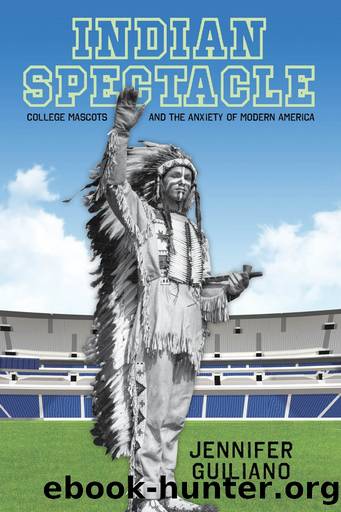Indian Spectacle by Jennifer Guiliano

Author:Jennifer Guiliano [Guiliano, Jennifer]
Language: eng
Format: epub
Tags: Social Science, Ethnic Studies, American, Native American Studies, Sports & Recreation, Cultural & Social Aspects, Discrimination, Indigenous Studies
ISBN: 9780813572741
Google: 6avrCQAAQBAJ
Publisher: Rutgers University Press
Published: 2015-04-02T04:25:03+00:00
FIGURE 11. H. D. âTimmâ Williams as Prince Lightfoot dancing at the California football game, 1953. Courtesy of the Stanford University Archives, Stanford Quad, 1953, 205. LD3047.Q4 V.60 1953.
Why the association with the Yuroks? The Yuroks, Algonquian-speaking Indians who migrated to California between the tenth and thirteenth centuries, were inhabitants of a reservation in the Klamath River valley in Northern California. First encountered by the Spanish in 1775 when a ship anchored at the coastal village Curey, the Yuroks had sporadic contact with Spanish and English colonizers prior to the mid-nineteenth century. In part because of the concentration of English colonial authority along the eastern seaboard, the Yuroks were relatively untouched by colonial Euro-American encounters prior to the 1849 California gold rush. In 1855, they were forcibly relocated to the Klamath River Reservation. One historian wrote in 1881 of the colonial encounter with the Yuroks: âA few years to come will see the last of these Indians, who once roamed the forests and mountains of Del Norte [County] in large numbers, and who could truly boast that they were âmonarchs of all they surveyed.â Flying before the march of civilization like chaff before the wind, they have rapidly been reduced in numbers, until at the present time [1881], a mere remnant of the earlier tribes are left to go down with the setting sun of their declining strength.â36 The common trope of the disappearing Indian was echoed by anthropologist A. L. Kroeber, who wrote of the Yuroks as having disappeared in the face of colonial encounters. In reality, the Yuroks, while dramatically affected by disease and the decline associated with colonialism, continued to fish, harvest, and work as loggers into the twentieth century. A subject of Edward Curtis, who also documented the Sioux, the Yuroks were presented in a variety of regalia. Performers of the White Deerskin Dance wore deer hide coverings, dentalia necklaces, and wolf-fur headbands, while Jump Dance performers were costumed in headdresses of woodpecker scalps, feathers, and deerskin robes. More commonly attired for the Curtis photos, Yuroks were usually dressed in loose-fitting pants and shirts with a beaded skullcap or headband.
Significantly, Williams was of Yurok ancestry. He initially performed along the sidelines, but rarely on the field. Williamsâs first authorized performance as Prince Lightfoot was at the Stanford UniversityâIllinois Rose Bowl game. Dancing at halftime, Williams appeared in a plains war bonnet, a half-star painted along his cheeks and chin, a fringed shirt with a loincloth, and fringed boots. In this moment of Yurok appropriation of Sioux identity, we see the culmination of the efforts by white middle-class men to create an American spectacle of college football that has been explored throughout this book. In Williamsâs choosing to portray himself as Sioux, the hierarchy of race that had positioned Indians as âechoesâ of American racial attitudes and colonial fears was inverted. The Illinois community had mentioned John Grableâs supposed Choctaw heritage but quickly obscured it in favor of recounting his Boy Scout training. At Stanford University, Williams,
Download
This site does not store any files on its server. We only index and link to content provided by other sites. Please contact the content providers to delete copyright contents if any and email us, we'll remove relevant links or contents immediately.
The Inner Game of Tennis by W. Timothy Gallwey(3576)
Unstoppable by Maria Sharapova(3485)
Urban Outlaw by Magnus Walker(3343)
Crazy Is My Superpower by A.J. Mendez Brooks(3334)
Mind Fuck by Manna Francis(3132)
The Social Psychology of Inequality by Unknown(2941)
The Fight by Norman Mailer(2849)
Unstoppable: My Life So Far by Maria Sharapova(2456)
Accepted by Pat Patterson(2310)
Futebol by Alex Bellos(2301)
Going Long by Editors of Runner's World(2298)
Motorcycle Man by Kristen Ashley(2200)
Sea Survival Handbook by Keith Colwell(2199)
The Happy Runner by David Roche(2195)
Backpacker the Complete Guide to Backpacking by Backpacker Magazine(2194)
The Sports Gene: Inside the Science of Extraordinary Athletic Performance by David Epstein(2135)
Peak: Secrets from the New Science of Expertise by Anders Ericsson & Robert Pool(1990)
Endure by Alex Hutchinson(1968)
The Call of Everest by Conrad Anker(1868)
